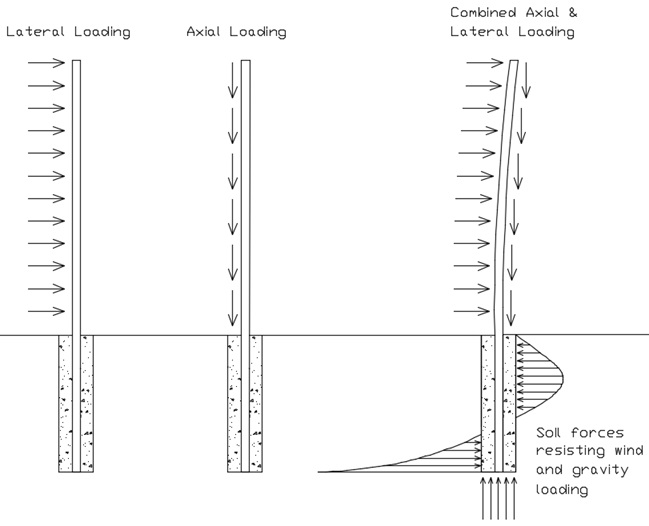Post Selection
A fence post has two main jobs. It must support the fencing materials and any ice that can build up on it, and resist wind forces. In bending under the wind, it acts as a beam. Resisting the vertical forces, it acts as a column. The more bending stress from the wind, the less available capacity the post has to resist gravity forces and vice versa. The post needs to be checked for the combined forces in both full wind loading plus the weight of the fencing, and for the lower wind speed for the ice loading case plus the weight of the fencing and ice, if applicable.

The charts below list the Bending Strength, Fa and Axial Strength, Pa of different posts at various fencing heights. Also listed are the weight of the posts, Dp in lbs / ft.
Look for post types in the desired size range that have higher Fa and Pa values than the fw‘, fi, pw & pi values calculated in the previous section.
Entries with an * next to the Axial Strength, Pa values exceed the stability ratio for normal columns so they would only be used if the 5 × px value is less than the Pa value. (pw or pi / Pa ≤ 0.2)
To get the total axial load including the weight of the post, calculate the following values for each post being checked.
pw‘ = pw + (Dp × h)
pi‘ = pi + (Dp × h)
If the strength ratios add up to a value ≤ 1.0, the post is acceptable.
If fw‘ / Fa + pw‘ / Pa ≤ 1.0, the post is OK for wind loading
If fi / Fa + pi‘ / Pa ≤ 1.0, the post is OK for wind & ice loading
Below is an example for a 10’ tall chain link fence in Pennsylvania. 105 mph wind, 40 mph gust speed for ice. (see Design Examples for full calcs)
Wind Loading
Wind force, fw‘ = 216 lbs Axial force, pw = 100 lbs
Wind on ice Loading – lower wind speed, but larger wind area due to ice build up
Wind Force, fi = 249 lbs
Axial Force including ice loading, pi = 540 lbs 5 × pi = 2,700 lbs
Ice loading controls. Desired post size is 2-7/8”. Look on the sample chart below for posts that have Fa & Pa values larger than the fi and pi values. If the post at that height has an * next to the Pa value, the 5 × pi value should be used for selection. Also note the post weight per foot, Dp.

10’ tall posts being checked that may resist the worst case bending load (249 lbs) combined with axial load (540 lbs or *2,700 lbs)
Both the posts have an * next to the Pa value, so the Pa value has to be more than 5 × pi which is 2,700 lbs for post selection only, not overall strength.
2-7/8” O.D. Schedule 40 / 30 ksi (Group 1A)
pi‘ = pi + (Dp × h) = 540 lbs + (5.8 lbs/ft × 10 ft) = 598 lbs
fi / Fa + pi’ / Pa = 249 / 408 + 598 / 3,418 = 0.79
Post is stressed to 79% of allowable capacity – OK
2-7/8” O.D. 40 Wt. / 50 ksi (Group 1C)
pi‘ = pi + (Dp × h) = 540 lbs + (4.6 lbs/ft × 10 ft) = 586 lbs
fi / Fa + pi’ / Pa = 249 / 547 + 586 / 2,818 = 0.66
Post is stressed to 66% of allowable capacity – OK
Post Strength Tables
ASTM F1043 Group IV / IV-L Circular Tubes – Residential / Light Industrial / Commercial
ASTM F1043 Group IA & IC Circular Tubes – Heavy Industrial
ASTM F2957 Square Aluminum Tubes (coming soon)
Roll Formed Posts – Residential Hat Channels and ASTM F1043 Group II / II-L C Channels
Next – Footing Design